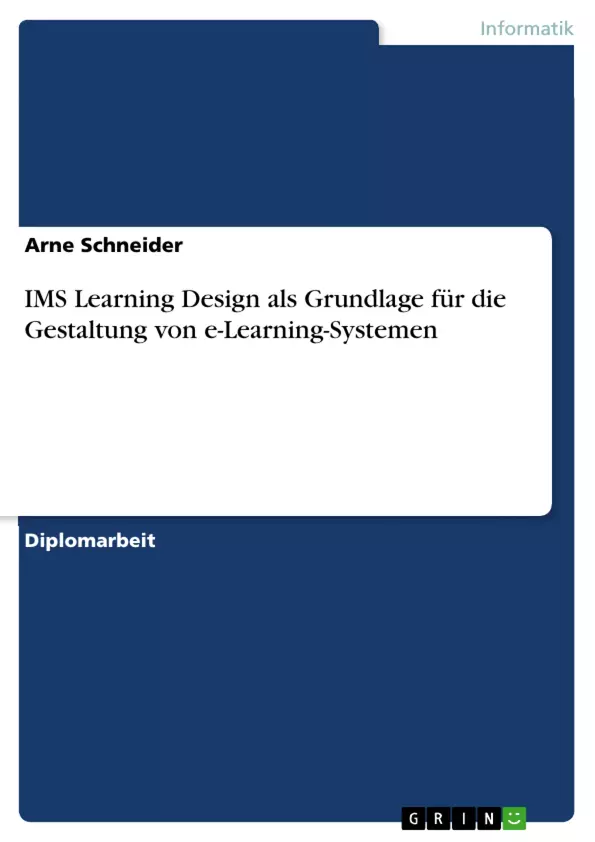In einem wachsenden Markt verteilter und unabgestimmter Entwicklungen und Technologien sind Standardisierungsmaßnahmen von entscheidender Bedeutung. Das Wachstum des e-Learning-Marktes und der damit einhergehende Wunsch nach Austauschbarkeit von Materialien (Contents) hat das Entstehen von Initiativen zur Schaffung von Standards gefördert. Um verteiltes Lernen zu ermöglichen, werden inzwischen unterschiedliche Spezifikationen entwickelt, die den Austausch von Lernmaterialien und Kursteilen unterstützen sollen. Das IMS Konsortium bietet mit dem IMS Learning Design und den darin eingebundenen Spezifikationen eine Lösung für die Integration und Wiederverwendbarkeit pädagogischer Elemente und Abläufe in Lehr-/ Lernszenarien.
Der Autor Arne Schneider gibt einführend einen Überblick über Standardisierungsgremien und -maßnahmen im e-Learning-Umfeld. Seine Beschreibung des IMS Learning Designs bildet anschließend die Grundlage für eine Untersuchung zur Adaption der IMS Spezifikationen. In diesem Zusammenhang vergleicht er die unterschiedlichen Standards, deren Marktdurchdringung und beschreibt Adaptionsszenarien für das IMS Learning Design.
Das Buch richtet sich an e-Learning Anbieter, an Kunden von e-Learning-Systemen und an alle, die sich über Standardisierungsaktivitäten im e-Learning-Bereich informieren möchten.
Inhaltsverzeichnis
- EINLEITUNG
- Problemstellung und Zielsetzung
- Gang der Untersuchung
- GRUNDLEGENDE BEGRIFFE
- STANDARDISIERUNGS-ORGANISATIONEN
- STANDARDS & SPEZIFIKATIONEN
- Standards für Metadaten
- Metadaten (Daten über Daten)
- XML
- Resource Description Framework (RDF)
- Dublin Core
- ARIADNE Educational Meta-data Specification (AMS)
- IMS (Instructional Management Systems)
- IMS Meta-data
- IMS Digital Repositories Interoperability
- IMS Content Packaging Specification
- IMS Question and Test Interoperability
- IMS Simple Sequencing Specification
- IMS Reusable Definition of Competency or Educational Objective
- IMS Learner Information Package
- IMS Enterprise
- IMS Guidelines for Developing Accessible Learning Applications
- IMS Learning Design Specification
- IMS LEARNING DESIGN
- UML
- Educational Modelling Language (EML)
- Neuerungen im IMS LD
- Solution for Everything?
- EMPIRISCHE UNTERSUCHUNG ZUR ADAPTION DER IMS SPEZIFIKATIONEN
- Fragestellungen
- Adaption IMS Meta-data, IMS CP, IMS SS
- Adaption der IMS QTI
- Adaption des IMS LIP
- Adaption des IMS Learning Designs
- Adaptionsszenario
- Fazit der Untersuchung
- ZUSAMMENFASSUNG UND AUSBLICK
Zielsetzung und Themenschwerpunkte
Diese Diplomarbeit befasst sich mit dem Thema IMS Learning Design als Grundlage für die Gestaltung von e-Learning-Systemen. Das Ziel ist es, die Konzepte und Anwendungsmöglichkeiten des IMS Learning Design im Kontext von e-Learning-Systemen zu untersuchen.
- Standards für Metadaten im e-Learning
- Das IMS Learning Design als Architekturmodell für e-Learning-Systeme
- Anwendbarkeit und Adaption von IMS Learning Design in der Praxis
- Empirische Untersuchung zur Adaption von IMS Spezifikationen
- Potenzial und Herausforderungen der IMS Standards
Zusammenfassung der Kapitel
- Einleitung: In diesem Kapitel wird die Problemstellung und Zielsetzung der Arbeit erläutert.
- Grundlegende Begriffe: Dieses Kapitel definiert wichtige Begriffe und Konzepte, die im weiteren Verlauf der Arbeit verwendet werden.
- Standardisierungs-Organisationen: Hier werden wichtige Standardisierungsorganisationen im Bereich e-Learning vorgestellt, die eine Rolle bei der Entwicklung der IMS Standards spielen.
- Standards & Spezifikationen: Dieses Kapitel befasst sich mit verschiedenen Standards und Spezifikationen für Metadaten im e-Learning, wobei der Fokus auf den IMS Standards liegt.
- IMS Learning Design: Dieses Kapitel behandelt das Konzept des IMS Learning Design und seine Bedeutung für die Gestaltung von e-Learning-Systemen.
- Empirische Untersuchung zur Adaption der IMS Spezifikationen: Dieses Kapitel präsentiert eine empirische Untersuchung zur Adaption von verschiedenen IMS Spezifikationen in der Praxis.
Schlüsselwörter
Die Arbeit konzentriert sich auf die Schlüsselthemen e-Learning, IMS Learning Design, Standardisierung, Metadaten, Architekturmodelle, e-Learning-Systeme und empirische Untersuchung zur Adaption von IMS Spezifikationen. Die Forschung zielt auf die Untersuchung des Potenzials von IMS Learning Design als Grundlage für die Gestaltung von e-Learning-Systemen.
- Quote paper
- Dipl. Kfm Arne Schneider (Author), 2004, IMS Learning Design als Grundlage für die Gestaltung von e-Learning-Systemen, Munich, GRIN Verlag, https://www.grin.com/document/51636



